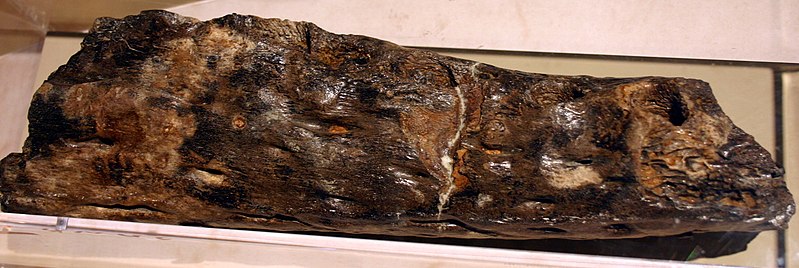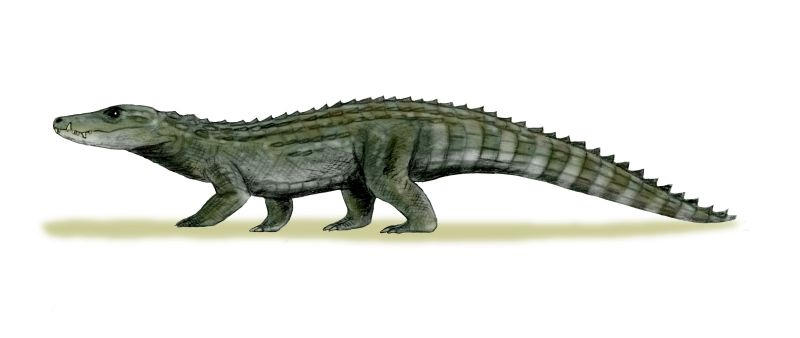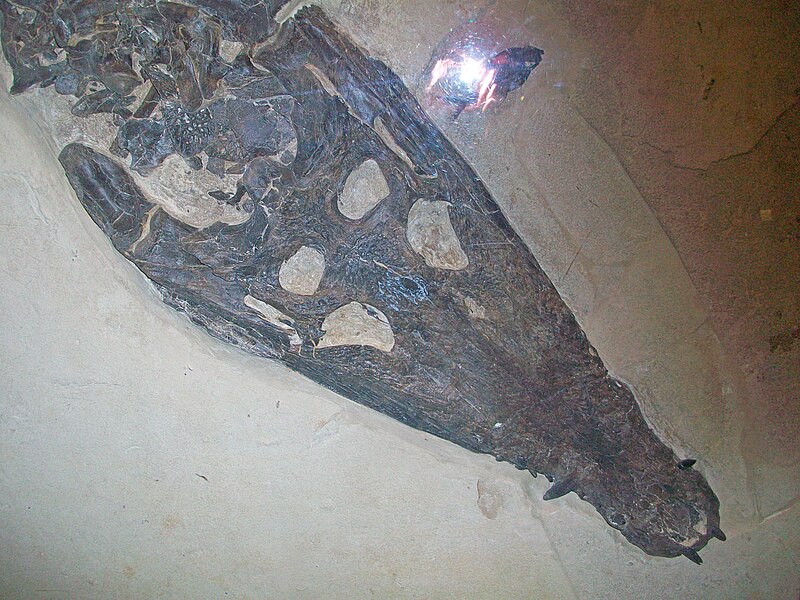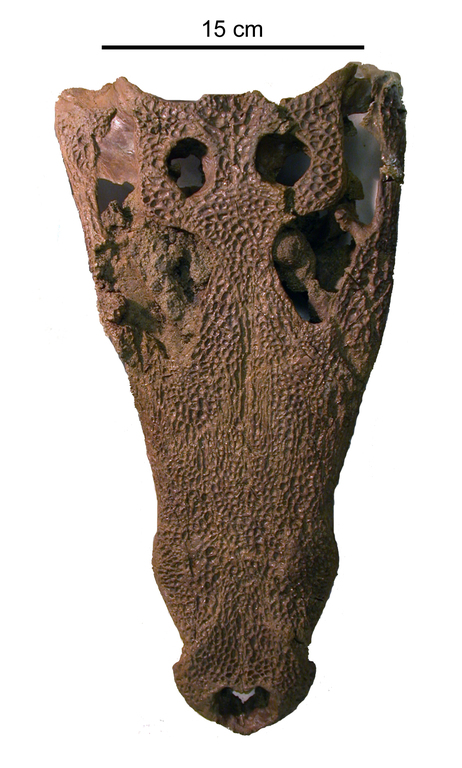[Recent Entries][Archive][Friends][User Info]
Below are the 7 most recent journal entries recorded in the "Сообщество, посвящённое ра" journal:| April 17th, 2014 | |
|---|---|
| 09:48 pm [industrialterro] [Link] |
Aegisuchus Aegisuchus is an extinct genus of giant, flat-headed crocodyliform within the family Aegyptosuchidae. It existed in what is now Morocco during the Cenomanian age of the Late Cretaceous Epoch. The type species Aegisuchus witmeri was named in 2012 by paleontologists Casey Holliday and Nicholas Gardner, who nicknamed it "Shieldcroc" for the shield-like shape of its skull. A. witmeri is known from a single partial skull including the braincase and skull roof. Aegisuchus is known only from a partial braincase and skull roof cataloged as ROM 54530. It is diagnosed by several autapomorphies, or unique features. At the center of the skull table is a raised and rough-surfaced boss on the parietal bone that is shaped like a circle. On either side of this boss are holes called dorsotemporal fenestrae, and the surrounding bone is relatively smooth. The quadrate bone in the temporal region of the skull has a rectangular projection called the adductor tubercle, which served as an attachment for muscles that closed the jaw. At the front of the skull table, projections on the laterosphenoid bones called capitate processes face out to the side. This feature is also seen in the skulls of living gharials, but evolved independently in each group. Also on the front surface are two holes of the dorsotemporal fenestrae, which pass through the skull and open at the skull table. On the front surface, a ridge of bone or torus makes up the lateral edge of each hole. The back of the skull is wide, with large projections on the exoccipital bones that would have anchored large epaxial muscles in the top part of the neck. At 40 cubic centimetres, the braincase of Aegisuchus is much larger in volume than that of any other crocodyliform. Based on the ratio of braincase to skull length in other crocodilians, the total skull length of Aegisuchus is estimated to have been 2.08 to 2.86 metres (6.8 to 9.4 ft) in length. A similar ratio between braincase and body length puts Aegisuchus at 15 to 21 metres (49 to 69 ft) long when based on the proportions of long-snouted gharials, or 16 to 22 metres (52 to 72 ft) long when based on the proportions of short-snouted crocodiles. Aegisuchus was almost certainly not this long, for it would be much longer than the largest of crocodilians, including Deinosuchus, Gryposuchus, Purussaurus, and Sarcosuchus. As a "duck-faced" crocodyliform, Aegisuchus may have had a longer snout relative to body length than living crocodylians. The circular boss of roughened bone on the skull table is one of the most unusual features of Aegisuchus. As in most crocodilians, the rough-surfaced region was probably covered in a thick skin that tightly adhered to the skull. Surrounding the boss, the smooth-surfaced region bears several deep parallel channels for blood vessels, suggesting that thicker, more complex skin tissue covered this region. Vascularization is not seen in any other crocodilian, and may have been unique to Aegisuchus. Given that the blood vessel channels run into the braincase, the vascularized tissue may have served a thermoregulatory role by heating blood going to the brain and eyes. The central boss may have been used in mating displays, appearing as an eyespot. Modern crocodilians raise their heads out of the water as a social signal in mating displays; as a close relative of crocodilians, Aegisuchus likely had similar mating rituals. The flattened shape of the skull of Aegisuchus suggests that it was an ambush predator resting at the surface of the water. Although only the back of the skull is known, other characteristics can be inferred from the closely related Aegyptosuchus. Aegisuchus probably had eyes that faced directly upward, with no raised ridges surrounding the sockets. A strut of bone called the postorbital bar, which in most crocodilians is vertically oriented, would have been almost flat. The flattened skull of Aegisuchus required significant alteration to jaw muscles. The adductor muscles that close the jaw shifted to a more vertical orientation in Aegisuchus. Muscles like the adductor mandibulae externus medialis, which are weak in most crocodilians, became more important as jaw closers and were greatly enlarged. The broad-surfaced occipital region at the back of the skull provides a large attachment area for the splenius capitis muscles of the neck. With a long flattened snout, Aegisuchus would have had great difficulty in raising its head and opening its mouth if it did not have large neck muscles. A depressed region in the lower part of the back of the skull suggests that the jaw adductor muscles were also large, facilitating jaw opening. A similar mechanism for lifting the head and opening the jaws is seen in the Late Triassic amphibian Gerrothorax. Aegisuchus has a very flexible articulation between the skull and vertebral column, allowing a greater degree of skull elevation than other crocodilians. During the Late Cretaceous, northern Africa was a humid region near the Tethys Ocean, a seaway between the southern continents of Gondwana and northern land masses of Laurasia. At this time, the Kem Kem Beds of Morocco were deposited in a freshwater delta system. Aegisuchus lived within this delta alongside fishes, turtles, snakes and varanid lizards, pterosaurs, and sauropod and theropod dinosaurs. Stomatosuchids are also known from the Kem Kem Beds, and probably shared a close ecological niche with Aegisuchus as river predators. With its flattened skull, Aegisuchus was probably an ambush predator. Possible prey include coelocanths, lungfish, and bichirs, all of which have been found in the Kem Kem beds. As an opportunistic predator, Aegisuchus may also have preyed on land vertebrates such as reptiles. The Late Cretaceous was an important time in crocodilian evolution because many land masses were breaking up. What is now Europe and Asia was drifting away from Africa to form the Tethys Ocean, while North America continued to separate from the rest of Laurasia as the Atlantic Ocean widened. With the presence of several early crocodilians like Borealosuchus, North America is often hypothesized as the continent of origin for Crocodylia. However, the presence of agyptosuchids such as Aegisuchus in northern Africa suggests that early crocodilian evolution was focused instead around the Tethys Ocean. The agyptosuchids represent a highly specialized and highly endemic branch of crocodyliforms at a time when crocodilian diversity and geographic range were expanding. ( Read More ) Tags: Вымершие рептилии, Мел, архозавроморфы, архозавры, диапсиды, египтозухиды, крокодиломорфы, круротарзы, мезоэукрокодилии, неозухии, равизухии, эузухии |
| April 15th, 2014 | |
| 08:45 pm [industrialterro] [Link] |
Deinosuchus Дейнозух (Deinosuchus, от др.-греч. δεινός σοῦχος «ужасный крокодил») — вымерший род аллигаторовых, живший 80—73 млн лет назад, в конце Мелового периода. Первые останки дейнозуха были обнаружены в Северной Каролине в начале 1850-х годов, однако он был описан и получил свое название лишь в 1909 году. Дополнительные фрагменты были найдены в конце 1940-х годов и позже были включены в серьёзную, хотя и неточную, реконструкцию черепа, выполненную Американским музеем естественной истории. Несмотря на то, что сведения о дейнозухе остаются неполными до сегодняшнего дня, лучший черепной материал, обнаруженный в последние годы, расширил научные знания об этом огромном хищнике. Хотя дейнозух был гораздо больше, чем любой современный крокодил или аллигатор (в длину он был около 14-15 метров и весил 8,5—9,4 тонн), по внешнему виду он был похож на своих меньших сородичей. Этот крокодил имел большие, крепкие зубы, предназначенные для дробления пищи, а спина у него была покрыта толстым слоем полусферических остеодерм. Одно исследование показывает, что дейнозухи, возможно, жили до 50 лет, соблюдая темпы роста современных крокодилов, но сохраняя способность к росту в течение гораздо более длительного периода времени. Окаменелости дейнозуха были найдены в десяти штатах США (Техас, Монтана и штаты вдоль Восточного побережья), а также на севере Мексики. Он жил по обе стороны Западного Внутреннего морского пути (Western Interior Seaway) и был сверххищником в прибрежных районах восточной части Северной Америки. Наибольшей численности популяция дейнозуха достигала в восточной части ареала, немного меньшей — в западной. Дейнозух, вероятно, был способен убивать и поедать крупных динозавров, помимо этого питаясь морскими черепахами, рыбой и другими водными и наземными животными. Несмотря на свои гораздо более крупные размеры, внешне дейнозух отличался от современных крокодилов незначительно. Дейнозух обладал аллигатороподобной широкой мордой со слегка выпуклым окончанием. На каждой переднечелюстной кости находилось по четыре зуба, из которых два ближайших к кончику морды были значительно меньше оставшихся. Каждая верхнечелюстная кость насчитывала 21 или 22 зуба. Число зубов на каждой нижнечелюстной кости было равно 22 или более. Все зубы были очень толстыми и прочными, а расположенные ближе к задней части челюстей зубы были округлыми и короткими. Предполагается, что заднечелюстные зубы были предназначены для дробления уже схваченной добычи. Когда рот крокодила закрывался, снаружи был виден только четвёртый зуб нижней челюсти. Современный морской крокодил имеет максимальную силу укуса в 16 480 ньютон на кв. дюйм, а сила укуса дейнозуха, по оценкам учёных, составляла 102 750 ньютон на кв. дюйм. Укус дейнозуха была примерно в два раза мощнее, чем у тираннозавра (57 000 ньютон на кв. дюйм) и значительно мощнее, чем у других тероподов. Дейнозух обладал вторичным костистым нёбом, которое позволяло ему дышать через ноздри, в то время как остальная часть головы оставалась погружённой в воду. Позвонки были процельными — полыми и вогнутыми спереди и выпуклыми сзади. Позвонки соединялись друг с другом по принципу «мяча и шарнира». Позвонки достигали в высоту до 30 см, поперечные отростки позвонков были очень длинными. Конечности дейнозуха относительно размеров тела были длиннее, чем у современных крокодилов. Вторичное нёбо и процельные позвонки также являются характерными признаками современных крокодилов эузухий. Остеодермы, покрывавшие спину дейнозуха, были необычайно большими, тяжёлыми и глубоко изборождёнными; некоторые из них были полусферической формы. Глубокие ямы и канавки на остеодермах служили точками крепления для соединительной ткани. Вместе остеодермы и соединительная ткань служили в качестве опоры для подъёма массивного тела дейнозуха из воды. Таким образом, несмотря на значительную массу, дейнозух был, вероятно, почти столь же гибким на суше, как и его современные родственники. Поскольку известные останки дейнозуха слишком фрагментарны, оценки его размеров значительно отличаются в рамках разных исследований. В 1954 году Эдвин Н. Кольбер и Роланд Т. Бёрд реконструировали нижнюю челюсть дейнозуха длиной 2 м (6,6 фута) и рассчитали «на основе сравнительных измерений», что общая длина тела гигантского крокодила могла быть до 15 м (50 футов). Значительное меньшее значение: 8—10 м (26—33 фута) — было предположено Грегори М. Эриксоном и Кристофером А. Брошу в 1999 году. Дэвид Р. Швиммер в 2002 году отмечал, что меньшая и более распространённая форма дейнозуха, ископаемые останки которой найдены на востоке Северной Америке, обычно обладала черепом длиной около 1 м (3,3 фута). Используя расчёты, основанные на промерах черепа, Швиммер предположил, что, вероятно, общая длина тела дейнозуха составляла около 8 м (26 футов), а вес — 2,3 т. По данным Швиммера, дейнозух достигал больших размеров в западной части континента. Достаточно хорошо сохранившийся образец черепа дейнозуха, найденный в Техасе, показывает, что длина головы животного составляла около 1,31 м (4,3 фута), и исходя из этого Швиммер определил общую длину тела этого экземпляра в 9,8 м (32,2 фута). Хотя крупнейшие останки черепов дейнозуха сохранились слишком плохо, чтобы использовать этот метод оценки, масштабирование от длины позвонков позволяет предположить, что наиболее крупные особи дейнозухов вырастали до ещё больших размеров. Швиммер оценил общую длину тела крупнейших экземпляров до 12 м (40 футов), а возможный вес — до 8,5 т или более. Хотя существуют некоторые разногласия относительно точного размера дейнозуха, тем не менее, его ископаемые останки достаточно убедительно доказывают, что дейнозух был существенно больше, чем любой современный крокодил. Даже относительно минимальные оценки его длины и веса, предлагаемые Эриксоном и Брошу, демонстрируют, что средний вес дейнозуха, превышает средний вес современных крокодилов в соотношении 3:5. Дейнозух часто описывается как самый крупный крокодил всех времён, однако некоторые ископаемые крокодилы, в том числе пурусзавры, рампохозухи и саркозухи, возможно, соответствовали или даже превосходили его по размерам. ( Read More ) Репродукции (1, 2, 3, 4, 5, 6, 7, 8, 9, 10): ( Read More ) Размеры тела в сравнении с человеком и другими гигантскими крокодилами (закрашен жёлтым): Ископаемые останки и реплики (1, 2, 3, 4, 5, 6, 7, 8): ( Read More ) Tags: Вымершие рептилии, Мел, аллигатороиды, архозавроморфы, архозавры, диапсиды, крокодиломорфы, крокодилы, круротарзы, мезоэукрокодилии, неозухии, равизухии, эузухии |
| April 14th, 2014 | |
| 09:52 pm [industrialterro] [Link] |
Leidyosuchus Leidyosuchus (meaning "Leidy's crocodile") is an extinct genus of alligatoroid from the Late Cretaceous of Alberta. It was named in 1907 by Lawrence Lambe, and the type species is L. canadensis. It is known from a number of specimens from the middle Campanian age Dinosaur Park Formation. It was a medium-sized alligatorid, with a maximum skull length greater than 40 centimeters (16 in). A number of species had been assigned to this genus over the years, including: L. acutidentatus (Sternberg, 1932), from the Paleocene of Saskatchewan; L. formidabilis (Erickson, 1976), from the Paleocene of North Dakota and Wyoming; L. gilmorei (Mook, 1942), from the Campanian of Alberta; L. multidentatus (Mook, 1930); L. riggsi (Schmidt, 1938); L. sternbergii (Gilmore, 1910), from the Maastrichtian (Late Cretaceous) of Colorado, Montana, North Dakota, South Dakota, and Wyoming; and L. wilsoni (Mook, 1959), from the Eocene of Wyoming. However, in 1997 Chris Brochu reevaluted the genus and reassigned most of the species, transferring L. acutidentatus, L. formidabilis, L. sternbergii, and L. wilsoni to the new genus Borealosuchus, and L. multidentatus to the new genus Listrognathosuchus, proposing L. gilmorei as a synonym of L. canadensis, and finding L. riggsi to be too fragmentary to be determinable. Alligatoroidea is a superfamily of crocodilians that evolved in the Late Cretaceous period. Cladistically, it is defined as Alligator mississippiensis (the American alligator) and all crocodylians more closely related to A. mississippiensis than to either Crocodylus niloticus (the Nile crocodile) or Gavialis gangeticus (the gharial). Tags: Вымершие рептилии, Мел, аллигатороиды, архозавроморфы, архозавры, диапсиды, крокодиломорфы, крокодилы, круротарзы, мезоэукрокодилии, неозухии, равизухии, эузухии |
| 09:36 pm [industrialterro] [Link] |
Thoracosaurus Thoracosaurus is an extinct genus of gavialoid crocodilian which existed during the Late Cretaceous and early Paleocene. It contains the species Thoracosaurus neocesariensis in North America and Thoracosaurus macrorhynchus in Europe. A number of species have been referred to this genus, but most are dubious. Thoracosaurus scanicus was a fairly large gavialid, with a length of more than 4.4 m (14.4 ft) and a 55 cm skull. European fossil remains from Thoracosaurus have been discovered in Ivö Klack on Ivö in Skåne, Sweden, and Denmark. Gavialoidea is one of three superfamilies of crocodylians, the other two being Alligatoroidea and Crocodyloidea. Although many extinct species are known, only the gharial Gavialis gangeticus and the false gharial Tomistoma schlegelii are alive today. Gavialoidea contains the family Gavialidae and several more basal extinct forms such as Thoracosaurus and Eosuchus. Within Gavialidae are two subfamilies: Gavialinae, which includes the living gharial, and Gryposuchinae, which includes several extinct forms such as Gryposuchus and Aktiogavialis. In addition to these groups, recent molecular studies consistently indicate that the false gharial (and by inference other related extinct forms) traditionally viewed as belonging to the crocodylian subfamily Tomistominae actually belong to Gavialoidea. As its name suggests, the false gharial was once thought to be only distantly related to the gharial despite its similar appearance. The false gharial and other tomistomines were traditionally classified within the superfamily Crocodyloidea as close relatives of crocodiles. This classification is based on morphological evidence, which, when incorporated into phylogenetic analyses, often place the group within Crocodyloidea. Ископаемые останки (1, 2, 3, 4, 5): Tags: Вымершие рептилии, Мел, архозавроморфы, архозавры, гавиалы, диапсиды, крокодиломорфы, крокодилы, круротарзы, мезоэукрокодилии, неозухии, равизухии, эузухии |
| 08:48 pm [industrialterro] [Link] |
Allodaposuchus Allodaposuchus is an extinct genus of eusuchian crocodylomorph and an early relative of crocodilians. It lived during the Upper Cretaceous (Campanian-Maastrichtian) in Southern Europe (Spain, Romania, and France). Like many other Cretaceous crocodylomorphs, Allodaposuchus has a relatively small body size compared to living crocodylians. The largest known specimen of Allodaposuchus belongs to an individual that was probably around 3 metres (9.8 ft) long. Allodaposuchus has a short, flattened, and rounded skull. Of the two known species, A. precedens has a brevirostrine or "short-snouted" skull with a snout about the same length as the skull table (the region of the skull behind the eye sockets) and A. subjuniperus has a mesorostrine or "middle-snouted" skull with a snout that is longer than the skull table. The main feature that distinguishes Allodaposuchus species from other related crocodylomorphs is the orientation of a groove at the back of the skull called the cranioquadrate passage; unlike the cranioquadrate passages of other crocodylomorphs, which are only visible at the back of the skull, the cranioquadrate passage of Allodaposuchus is visible when the skull is viewed from the side. The type species of Allodaposuchus, A. precedens, was named by Hungarian paleontologist Franz Nopcsa in 1928 from Vălioara, Romania. Nopcsa found bone fragments in a deposit of the Hațeg Basin that dates back to the late Maastrichtian stage - the very end of the Late Cretaceous. Several partial skulls from Spain and France were attributed to A. precedens in 2001. Some of these skulls came from Campanian-age deposits slightly older than those in Romania, meaning that the species must have persisted for about 5 million years. In 2013 a second species of Allodaposuchus, A. subjuniperus, was named on the basis of a skull from the late-Maastrichtian Conqués Formation in the province of Huesca, Spain. The skull was found underneath a juniper tree whose roots had grown between the bones, hence the species name subjuniperus or "under juniper" in Latin. The 2013 study also proposed that the French and Spanish fossils assigned to A. precedens in 2001 might actually represent a new unnamed species of Allodaposuchus currently identified as Allodaposuchus sp. A study published in 2005 had suggested that these fossils belong to several different genera of crocodylomorphs and that the original Romanian material is too fragmentary to assign to its own genus, making Allodaposuchus a nomen dubium or "dubious name". However, the 2013 study reaffirmed the Romanian material's distinctiveness from other European Cretaceous crocodylomorphs and therefore reaffirmed the validity of Allodaposuchus as a genus. Allodaposuchus is a close relative of modern crocodylians but it is not itself a member of Crocodylia, the most exclusive group including all modern crocodylians. It is an early member of a larger clade or evolutionary group called Eusuchia that originated in the Early Cretaceous. Allodaposuchus is part of an evolutionary radiation of eusuchians that happened later in the Cretaceous as they spread to multiple continents. When Franz Nopcsa named Allodaposuchus, he proposed that it was a close relative of Leidyosuchus, a crocodylian from Canada. However, Nopsca could only base this assignment on a few fragments of bone. After more complete material was uncovered from Spain and France, Allodaposuchus was reinterpreted as a non-crocodylian eusuchian in 2001. The 2001 study recognized a close relationship between Allodaposuchus and Hylaeochampsa, a eusuchian from the Early Cretaceous of England. A 2010 phylogenetic analysis supported a relationship similar to Nopsca's by placing Allodaposuchus within Alligatoroidea, a group of crocodylians that includes modern-day alligators and Leidyosuchus. Tags: Вымершие рептилии, Мел, архозавроморфы, архозавры, диапсиды, крокодиломорфы, круротарзы, мезоэукрокодилии, неозухии, равизухии, эузухии |
| 08:37 pm [industrialterro] [Link] |
Borealosuchus Borealosuchus is an extinct genus of crocodylians that lived from the Late Cretaceous to the Eocene in North America. It was named by Chris Brochu in 1997 for several species that had been assigned to Leidyosuchus. The species assigned to it are: B. sternbergii, the type species, from the Maastrichtian (Late Cretaceous) of Colorado, Montana, North Dakota, South Dakota, and Wyoming; B. acutidentatus, from the Paleocene of Saskatchewan; B. formidabilis, from the Paleocene of North Dakota and Wyoming; B. griffithi, from the Paleocene of Alberta; and B. wilsoni, from the Eocene of Wyoming. B. formidabilis is particularly well-known, represented by the remains of many individuals from the Wannagan Creek site in North Dakota. Borealosuchus was a mid-sized crocodylian; B. acutidentatus reached up to 2.8 metres (9.2 ft) in length with a 36 centimetres (14 in) skull. Six species of Borealosuchus are currently recognized. In order of their naming, they are B. sternbergii, B. acutidentatus, B. wilsoni, B. formidabilis, B. griffithi, and B. threeensis. Four of these species (B. sternbergi, B. acutidentatus, B. wilsoni, and B. formidabilis) were originally named as species of Leidysuchus. A sixth species of Borealosuchus, B. threeensis, was named in 2012. Fossils of this species were found in the Inversand Company Marl Pit of Gloucester County, New Jersey. The specific name is a reference to Exit 3 of the New Jersey Turnpike, which is the closest highway exit to the type locality. The authors of the paper describing B. threeensis noted that the name is "in reference to a question every New Jersey resident encounters when traveling: 'Oh, you’re from New Jersey? Which exit?". According to Brochu et al. (2012) most phylogenetic analyses recovered Borealosuchus as a crocodylian more closely related to the clade Brevirostres than to Gavialoidea; a few recovered it as more closely related to gavialoids or as a basal eusuchian not belonging to Crocodylia. According to Brochu and coauthors' (2012) own analysis, all three hypotheses are equally parsimonious. Ископаемые останки (1, 2, 3, 4): Tags: Вымершие рептилии, Мел, архозавроморфы, архозавры, диапсиды, крокодиломорфы, крокодилы, круротарзы, мезоэукрокодилии, неозухии, равизухии, эузухии |
| April 13th, 2014 | |
| 09:12 pm [industrialterro] [Link] |
Isisfordia Isisfordia (named after the discoverer; former Deputy Mayor of Isisford, Ian Duncan) (holotype QM F36211) is an extinct genus of crocodyliform closely related to crocodilians that lived during the Middle Cretaceous (Albian–Cenomanian). Its fossils were discovered in the Winton Formation in Isisford, Queensland, Australia in the mid-1990s. Most of the animal was discovered, with the exception of the front portion of the skull. On a later expedition to the location, paleontologists discovered a complete skull which differed from the original specimen in size only. The estimate of the length of Isisfordia is about 1.1 m (3.6 feet). The discovery of the fossilized remains led paleontologists to suggest that the group including modern crocodilians first evolved 30 million years earlier than previously thought, during the Cretaceous period on the supercontinent Gondwana. Analysis of the remains concluded that the vertebrae fit together as they do in modern crocodilians, via loose ball-and-socket joints, as well as a secondary palate similar to that in living crocodilians which allows them to let air pass into the lungs without entering the inside of the mouth. Eusuchia — клада рептилий, существующая с начала мелового периода (Hylaeochampsa). Все современные крокодилы, а также часть вымерших, входят в кладу Eusuchia. В отличие от примитивных крокодиломорфов, Crocodyliformes имеют вторичное костное нёбо. Это даёт им возможность дышать через нос. У Eusuchia вторичное костное нёбо наиболее развитое.
Ископаемые останки (1, 2, 3, 4): Tags: Вымершие рептилии, Мел, архозавроморфы, архозавры, диапсиды, крокодиломорфы, круротарзы, мезоэукрокодилии, неозухии, равизухии, эузухии |











































